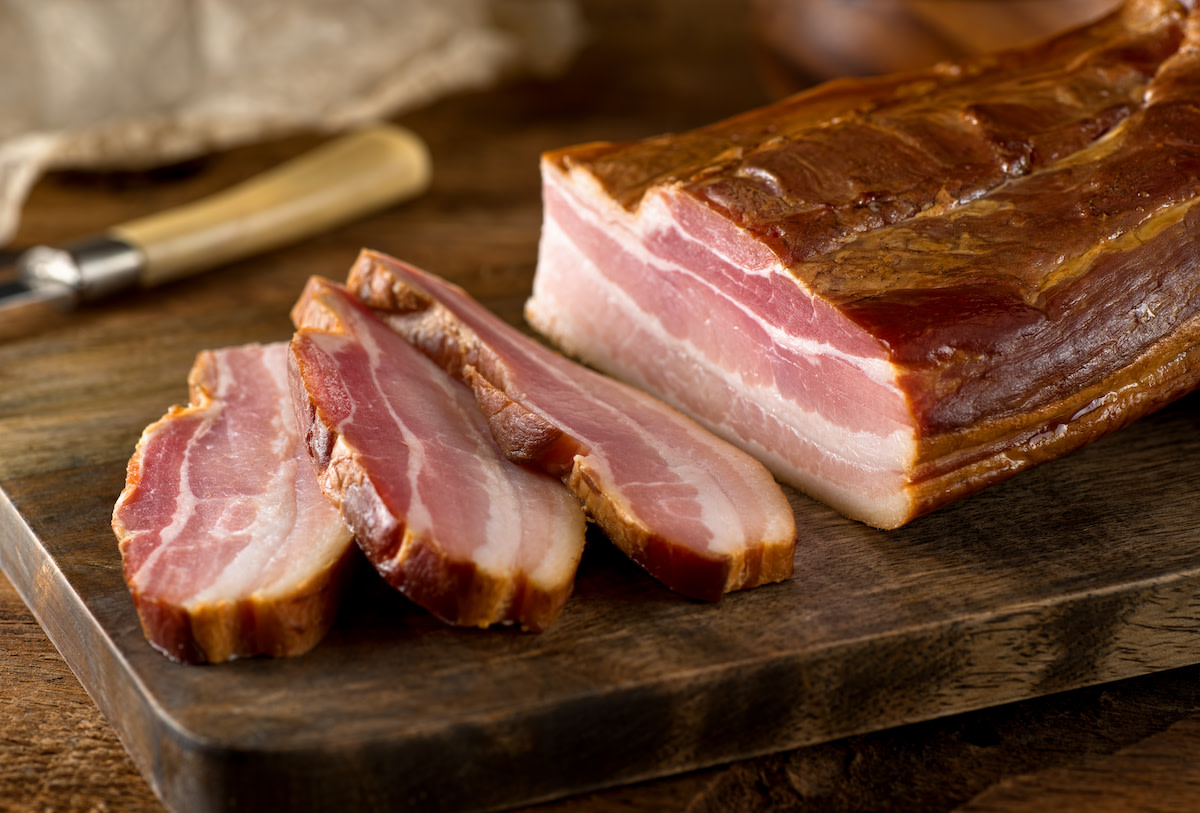What’s the Difference Between Pancetta, Bacon, and Prosciutto?
Written by MasterClass
Last updated: Aug 10, 2021 • 4 min read
Prosciutto, pancetta, and bacon are all cured meats that look and taste somewhat similarly; but their appearance, texture, and taste differ depending on where the meat comes from, the breed of pig it comes from, and how it’s cured. While you can usually get away with substituting the three meats seamlessly, prosciutto, pancetta, and bacon are all quite different from one another.
Learn From the Best
What Is Pancetta?
Pancetta is seasoned, salt-cured meat cut from pork belly, the underside of the pig. Pancetta is light pink with a dense, silky texture, and nutty flavor. Pancetta is commonly sold in thin slices in Italy, but most often sold cubed in the United States.
How Is Pancetta Made?
It takes about three weeks from start to finish to make pancetta:
- Pork belly is seasoned with salt, pepper, and seasonings like juniper berries, coriander, and fennel seeds.
- This is refrigerated for a week or until firm, up to 10 days.
- The meat is washed and brushed to remove all of the seasonings, then reseasoned with pepper.
- The meat is rolled tightly into a cylinder, slipped into a casing, and tied with butcher’s twine in one-inch intervals.
- The pancetta is then is hung in a slightly cool, dry place to cure completely—about two to three weeks.
What Is Bacon?
Bacon is a smoke-cured meat made from pig’s belly. Different types of wood are used to smoke the bacon, such as applewood or maplewood, which gives the bacon the flavor of those respective trees. Once smoked, bacon is deep pink, has a golden rind, and can be cut either thick or thin. Other countries have different types of bacon, and this type of bacon is called “American bacon” or “streaky bacon” outside of the United States.
How Are Pancetta and Bacon Different?
The biggest difference between pancetta and bacon is that bacon is smoked and pancetta is salt-cured and dried. In terms of cooking, this means that bacon is still raw and should be cooked while pancetta can be eaten both cooked or uncooked. Bacon and pancetta are cut from the same part of the pig, which means you can cook with pancetta and bacon almost interchangeably; it’s a matter of preference whether you want the saltiness of pancetta or smokiness of bacon.
4 Ways to Use Pancetta or Bacon in the Kitchen
There are many ways to incorporate either pancetta or bacon into your cooking.
- 1. Wrap slices of pancetta or bacon around meat, seafood, or vegetables before cooking for added savoriness and crunch.
- 2. Use bacon or pancetta as a pizza topping.
- 3. Render the fat from bacon or pancetta before cooking the vegetables in a soup to give an added depth to the flavor.
- 4. Add cooked and cubed pancetta or bacon to regular tomato pasta sauce with pecorino cheese to make a quick amatriciana.
What Is Prosciutto?
Prosciutto is uncooked, salt-cured hind leg of a pig. Prosciutto means ham in Italian, and the type of prosciutto most common in the United States is actually called prosciutto crudo in Italy (which is different from cooked prosciutto, known as prosciutto cotto).
Prosciutto is a fatty cut of meat typically sold in paper-thin slices. Prosciutto has a rosy color and a soft, buttery texture. Many Italian regions have their own types of prosciutto crudo that are protected by a European Union law called a Protected Designation of Origin (PDO). This law which helps consumers identify authentic prosciutto and allow producers sell their protected products at a premium price.
The most well-known and exported prosciutto in Italy is prosciutto di Parma or Parma ham. Parma, Italy is known for making another famous protected product—parmigiano reggiano or parmesan cheese.
How Is Prosciutto Made?
Making prosciutto is a lengthy process that takes over a year to complete:
- The cut hind leg is heavily salted and refrigerated for a week.
- After this, the leg is salted again, hung, and refrigerated for another two to three months to allow the salt to fully absorb.
- The meat is washed and brushed to remove the salt, then hung for a few more days.
- The leg is then hung at room temperature for three months to begin drying and hardening. The meat is softened with a lard, salt, and pepper mixture so it doesn’t dry out too quickly.
- The prosciutto is transferred to a cellar with less light and less air to cure completely. Prosciutto cures for at least nine months, with some curing for three years. By law, Prosciutto di Parma must be cured for at least 400 days.
4 Ways to Use Prosciutto in the Kitchen
- 1. Serve prosciutto by itself as an easy appetizer that doesn’t require any cooking or preparation.
- 2. Wrap prosciutto around chunks of parmesan or include piled slices of prosciutto on your cheese board.
- 3. Wrap it around cooked vegetables like asparagus or broccoli.
- 4. Add prosciutto rinds to soups, stews, broths, risottos, and pasta sauces to build flavor. Prosciutto rinds are not usually for sale at the deli counter, so ask your butcher if they have any on hand.
How Is Prosciutto Different From Pancetta and Bacon?
The main way prosciutto differs from pancetta and bacon is the curing process. It takes about 10 days to make bacon and three weeks to make pancetta, but it takes a year or more to make prosciutto. Additionally, you can cook with pancetta and bacon almost interchangeably because they’re cut from the same part of the pig. You cannot as easily substitute prosciutto for bacon or pancetta because the cut of meat and curing process are different. Prosciutto is intended to be eaten uncooked, while bacon must be cooked and pancetta can be cooked or eaten raw.
